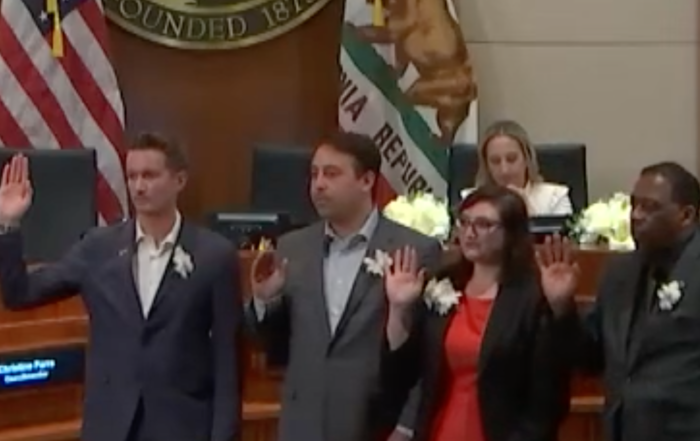On Tuesday evening, the Beverly Hills City Council heard a staff report charting the progress the city has made thus far to meet the ambitious requirements of the State’s Housing and Community Development (HCD) Department. Every eight to nine years, a new housing cycle begins and based on the progress of the previous one, a Regional Housing Needs Assessment (RHNA) goal for the number of housing units each city must produce is developed.
For the 2021-2029 Sixth Cycle Housing Element, HCD determined through the RHNA process that Beverly Hills must build 3,104 units, or have identified where they will be built, or face state penalties. On top of the overall number, income levels for the affordability of units needed are also determined, and for the Sixth Cycle, Beverly Hills needs to strive to meet the following:
- Very Low Income (Up to 50 percent of Average Monthly Income [AMI]) = 1,002 housing units, or 32 percent of total required
- Low Income (51-80 percent of AMI) = 680 housing units, or 22 percent of the total required
- Moderate Income (81-120 percent of AMI) = 602 housing units, or 19 percent of total required
- Above Moderate Income (121 percent+ of AMI) = 814 housing units, or 26 percent of the total required
On hand to present the report was Timothea “Timmi” Tway, the city’s Director of Community Development, who reminded the council that this month’s report meets an annual state requirement to update the council on progress and programs in place to help the city meet its Housing Element goals.
According to Tway, council and staff have achieved several accomplishments in various segments of the Housing Element, including:
- Adopting a required Safety Element for construction
- “Complete Streets” Implementation and “Connect BH” streetscape standards, which align more with the overall General Plan
- Increasing homeless services and social service response
- Launched a City-initiated Affordable Housing project
In addition, and according to the Staff Report prepared for this meeting by the City Planning Department, progress was made in the following specific ways:
- “A total of 25 accessory dwelling units (ADUs) were permitted, and one new 17-unit market-rate multi-family residential project received a building permit in 2022. Between the ADUs and multi-family units, the City permitted 42 new net housing units (above moderate income) in 2022.”
- “A total of 319 units, of which 3 are low-income units, 20 are very low-income units, and 55 are senior housing units, are currently under review for entitlements.”
- “The City approved entitlements for 30 net new housing units, of which 4 are very low-income units and 2 are low-income units, though these projects have not yet been issued building permits.”
It would only be fair to admit that the City of Beverly Hills would have to play some serious catch-up given the limited numbers above against the 3,104 required.
Former resident James Wendell called into the meeting to say that he lived in Beverly Hills back in 2005, but “Unfortunately, due to illegal AirBNBs and landlords, with lack of protections for young renters, I was a victim of circumstance.” He explained that as a person with a disability, he needed affordable housing options and relies on the subsidies he was provided. And yet, he received no protections from the landlords unjustifiably evicting residents like him to convert units to short-term vacation rentals. Wendell added, “And, I’ve been disappointed because this is the second or third iteration of a Housing Element – I started in 2011, and here we are in 2023 – and the city has made some effort to provide certain units, but nothing to the state’s satisfaction. Unfortunately, because of 50-60 years of not dealing with this issue, it has exacerbated to the degree that low-income, very low-income housing, is basically not even in consideration.” He also suggested that landlords don’t welcome the construction of, or requirements to provide such units.
None of the councilmembers had either technical questions or comments on the latest report. Only about 13 total minutes were spent on the Housing Element Tuesday evening.
Having some questions for the city of my own, I asked Tway whether it was fair to say Beverly Hills has a history over the last 40-50 years of resisting multi-family housing development in favor of building out its higher-income single-family housing. And if unfair, what evidence could they provide?
Without taking responsibility for past wrongs, Tway responded, “The City’s current and previous housing elements contain many policies and programs that are meant to remove barriers to the provision of housing, encourage the rehabilitation of existing housing, and create new housing opportunities in the City. The actions in this plan will be implemented over the next several years as the City carries out the commitments in the plan.”
But does Mr. Wendell have a point – are people like him welcome in Beverly Hills?
Tway stuck to her talking points, saying, “The City of Beverly Hills welcomes everyone, of all income levels to make Beverly Hills home. Several years ago, the City adopted a mixed-use overlay zone that applies to major commercial corridors in the City and allows for the development of housing units where they previously were not allowed. This new zone provides capacity for several thousand additional housing units in the City without displacing existing residents and also allows the conversion of existing commercial buildings in this zone to residential units.”
One must ask whether lower-income disabled residents needing subsidies like Mr. Wendell will have a place in one of those “several thousand additional housing units.”
Looking at the low numbers above either identified for development or produced so far, how can the city say it’s serious about meeting HCD requirements over the next six years?
Again, Tway responded by trying to present a progressive outlook, explaining that, “In 2021, the City Council adopted permanent ‘inclusionary housing’ regulations, which require new housing developments to include a certain percentage of deed-restricted affordable housing in order to further create deed-restricted affordable units in the City (very low, low, or moderate-income units). Today there are approximately 300 new housing units that are under review in the Community Development department and will come forward for approval in the next two years.”
One can only hope there will be more help than this if RHNA targets are to be met. But she did add, “Additionally, last year the City released an RFP/Q to identify qualified developers to partner with the City to develop an affordable senior housing project on City-owned property.”
Leonora Camner, Executive Director of Abundant Housing L.A., an organization that argues for a huge increase in housing development to meet our regional needs, was asked what she thought of the city’s responses. Camner, who has been critical of the city’s housing policies, held nothing back, saying, “Don’t be fooled by the city’s claims to be working toward affordability. Planning for housing affordability isn’t rocket science: cities just have to zone land for apartments, then actually let people build them. Beverly Hills chooses not to do this. The city has repeatedly rejected widely known best practices, as well as expert advice from Abundant Housing and the state of California’s Department of Housing and Community Development, in order to maintain the city’s exclusivity by keeping more than three-quarters of the city’s land zoned exclusively for mansions while allowing apartments only where the city knows they won’t be built.”
Camner also expects the city’s latest attempts to go through the motions on changes to the Housing Element to be further rejected by HCD.
Follow Westside Voice for continued coverage of Beverly Hill’s progress, or lack thereof, on producing needed increases in housing and affordable housing.
Photo by David Vives
Stay informed. Sign up for The Westside Voice Newsletter
By clicking submit, you agree to share your email address with Westside Voice. We do not sell or share your information with anyone.








